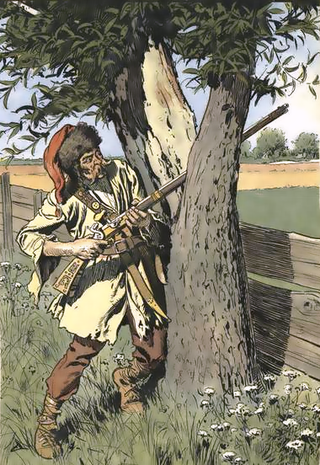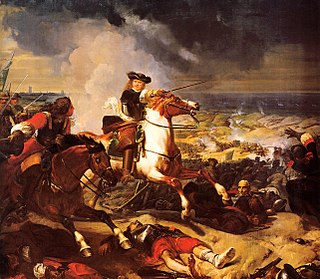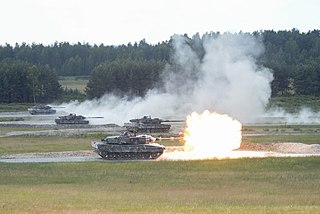Related Research Articles

A battle is an occurrence of combat in warfare between opposing military units of any number or size. A war usually consists of multiple battles. In general, a battle is a military engagement that is well defined in duration, area, and force commitment. An engagement with only limited commitment between the forces and without decisive results is sometimes called a skirmish.

Infantry is a specialization of military personnel who engage in warfare combat. Infantry generally consists of light infantry, irregular infantry, heavy infantry, mountain infantry, motorized infantry, mechanized infantry, airborne infantry, air assault infantry, and naval infantry. Other types of infantry, such as line infantry and mounted infantry, were once commonplace but fell out of favor in the 1800s with the invention of more accurate and powerful weapons.
Military tactics encompasses the art of organizing and employing fighting forces on or near the battlefield. They involve the application of four battlefield functions which are closely related – kinetic or firepower, mobility, protection or security, and shock action. Tactics are a separate function from command and control and logistics. In contemporary military science, tactics are the lowest of three levels of warfighting, the higher levels being the strategic and operational levels. Throughout history, there has been a shifting balance between the four tactical functions, generally based on the application of military technology, which has led to one or more of the tactical functions being dominant for a period of time, usually accompanied by the dominance of an associated fighting arm deployed on the battlefield, such as infantry, artillery, cavalry or tanks.
Military strategy is a set of ideas implemented by military organizations to pursue desired strategic goals. Derived from the Greek word strategos, the term strategy, when first used during the 18th century, was seen in its narrow sense as the "art of the general", or "the art of arrangement" of troops. and deals with the planning and conduct of campaigns, the movement and disposition of forces, and the deception of the enemy.

A charge is an offensive maneuver in battle in which combatants advance towards their enemy at their best speed in an attempt to engage in a decisive close combat. The charge is the dominant shock attack and has been the key tactic and decisive moment of many battles throughout history. Modern charges usually involve small groups of fireteams equipped with weapons with a high rate of fire and striking against individual defensive positions, instead of large groups of combatants charging another group or a fortified line.

Skirmishers are light infantry or light cavalry soldiers deployed as a vanguard, flank guard or rearguard to screen a tactical position or a larger body of friendly troops from enemy advances. They are usually deployed in a skirmish line, an irregular open formation that is much more spread out in depth and in breadth than a traditional line formation. Their purpose is to harass the enemy by engaging them in only light or sporadic combat to delay their movement, disrupt their attack, or weaken their morale. Such tactics are collectively called skirmishing. A combat with only light, relatively indecisive combat is often called a skirmish even if heavier troops are sometimes involved.

Early modern warfare is the era of warfare during early modern period following medieval warfare. It is associated with the start of the widespread use of gunpowder and the development of suitable weapons to use the explosive, including artillery and firearms; for this reason the era is also referred to as the age of gunpowder warfare.

Air assault is the movement of ground-based military forces by vertical take-off and landing (VTOL) aircraft, such as helicopters, to seize and hold key terrain that has not been fully secured, and to directly engage enemy forces behind enemy lines. In addition to regular infantry training, air-assault units usually receive training in rappelling, fast-roping techniques, and air transportation. Their equipment is sometimes designed or field-modified to allow better transportation and/or carrying within aircraft.

Maneuver warfare, or manoeuvre warfare, is a military strategy which emphasizes movement, initiative and surprise to achieve a position of advantage. Maneuver seeks to inflict losses indirectly by envelopment, encirclement and disruption, while minimizing the need to engage in frontal combat. In contrast to attrition warfare where strength tends to be applied against strength, maneuver warfare attempts to apply strength against weakness in order to accomplish the mission.

In the field of military theory, the operational level of war represents the level of command that connects the details of tactics with the goals of strategy.

Armoured warfare or armored warfare, is the use of armoured fighting vehicles in modern warfare. It is a major component of modern methods of war. The premise of armored warfare rests on the ability of troops to penetrate conventional defensive lines through use of manoeuvre by armoured units.

A pitched battle or set-piece battle is a battle in which opposing forces each anticipate the setting of the battle, and each chooses to commit to it. Either side may have the option to disengage before the battle starts or shortly thereafter. A pitched battle is not a chance encounter such as a meeting engagement, or where one side is forced to fight at a time not of its choosing such as happens in a siege or an ambush. Pitched battles are usually carefully planned to maximize one's strengths against an opponent's weaknesses and use a full range of deceptions, feints, and other manoeuvres. They are also planned to take advantage of terrain favourable to one's force. Forces strong in cavalry, for example, will not select swamp, forest, or mountain terrain for the planned struggle. For example, Carthaginian General Hannibal selected relatively flat ground near the village of Cannae for his great confrontation with the Romans, not the rocky terrain of the high Apennines. Likewise, Zulu Commander Shaka avoided forested areas or swamps, in favour of rolling grassland, where the encircling horns of the Zulu Impi could manoeuvre to effect. Pitched battles continued to evolve throughout history as armies implemented new technology and tactics.
Deep operation, also known as Soviet deep battle, was a military theory developed by the Soviet Union for its armed forces during the 1920s and 1930s. It was a tenet that emphasized destroying, suppressing or disorganizing enemy forces not only at the line of contact but also throughout the depth of the battlefield.

Infantry tactics are the combination of military concepts and methods used by infantry to achieve tactical objectives during combat. The role of the infantry on the battlefield is, typically, to close with and engage the enemy, and hold territorial objectives; infantry tactics are the means by which this is achieved. Infantry commonly makes up the largest proportion of an army's fighting strength, and consequently often suffers the heaviest casualties. Throughout history, infantrymen have sought to minimise their losses in both attack and defence through effective tactics.

Firepower is the military capability to direct force at an enemy. Firepower involves the whole range of potential weapons. The concept is generally taught as one of the three key principles of modern warfare wherein the enemy forces are destroyed or have their will to fight negated by sufficient and preferably overwhelming use of force as a result of combat operations.

Shock tactics, shock tactic, or shock attack is an offensive maneuver which attempts to place the enemy under psychological pressure by a rapid and fully-committed advance with the aim of causing their combatants to retreat. The acceptance of a higher degree of risk to attain a decisive result is intrinsic to shock actions.
An offensive is a military operation that seeks through an aggressive projection of armed forces to occupy or recapture territory, gain an objective or achieve some larger strategic, operational, or tactical goal. Another term for an offensive often used by the media is "invasion", or the more general "attack". An offensive is a conduct of combat operations that seek to achieve only some of the objectives of the strategy being pursued in the theatre as a whole. Commonly an offensive is carried out by one or more divisions, numbering between 10 and 30,000 troops as part of a combined arms manoeuvre.

Despite the rise of knightly cavalry in the 11th century, infantry played an important role throughout the Middle Ages on both the battlefield and in sieges. From the 14th century onwards, it has been argued that there was a rise in the prominence of infantry forces, sometimes referred to as an "infantry revolution", but this view is strongly contested by some military historians.

African military systems (1800–1900) refers to the evolution of military systems on the African continent after 1800, with emphasis on the role of indigenous states and peoples within the African continent. Only major military systems or innovations and their development after 1800 are covered here. For events prior to 1800, see African military systems to 1800. Coverage of the late 19th/20th century and beyond is provided in African military systems after 1900. For an overall view of the military history of Africa by region, see Military History of Africa. See individual battles, empires and leaders for details on activities after 1800.

Although the term infantry dates from the 15th century, the foot troops of the previous eras in history who fought with a variety of weapons before the introduction of the firearms are also referred to as infantry. During the Ancient and Middle Ages infantry were often categorized by the types of weapons and armour they used, such as heavy infantry and light infantry. Generally, light infantry acted as skirmishers, scouts, and as a screening force for the more heavily armed and armored heavy infantry, the latter of which often made up the bulk of many historic armies.
References
- De La Barre Duparcq, Nicolas Édouard, Translated by George Washington Cullum, (Brig.Gen.)Elements of Military Art and History: Comprising the History and Tactics of the Separate Arms; the Combination of the Arms; and the Minor Operations of War, D. Van Nostrand, New York, 1863
- Halleck, H. Wager, (Mag.Gen.), Elements of Military Art and Science, D. Appleton & company, New York, 1862